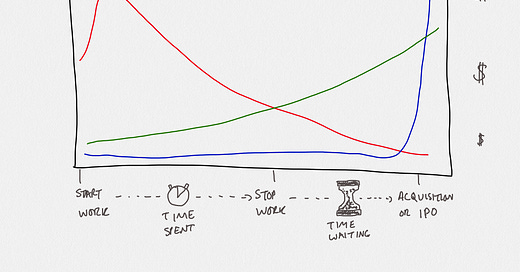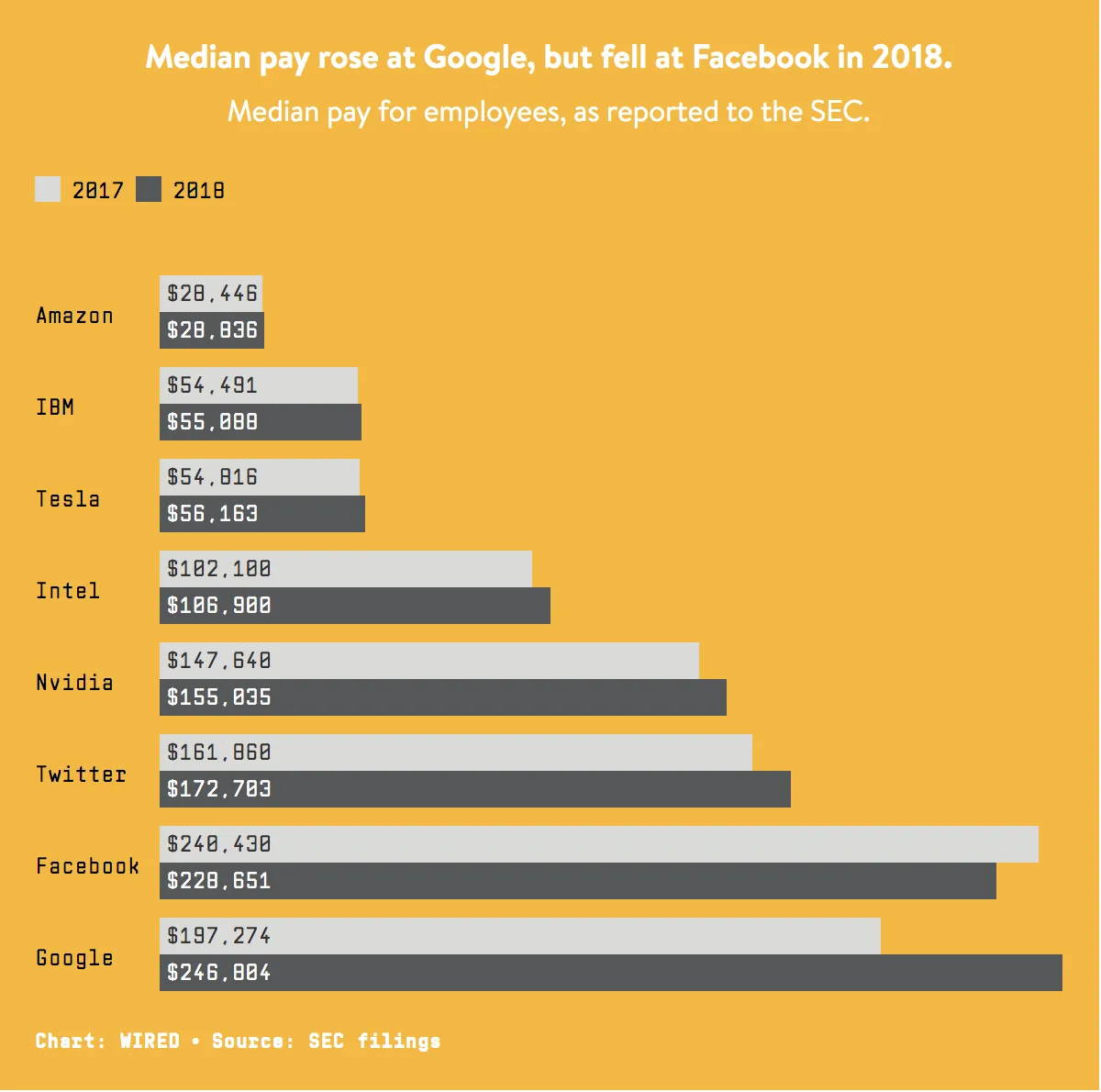Stock options are a fascinating form of human coordination. When Silicon Valley companies started to include employees in the upside, innovation in the area went into overdrive.
From the early days of Hewlett-Packard to recent examples like Facebook. Stock options helped the first 3,000 employees of Facebook enjoy roughly $23 billion at the time the company went public.*
https://www.holloway.com/g/equity-compensation/sections/history-and-significance
When Ethereum was launched, everyone was promised something totally new: a token.


Instead of an option to buy a piece of a company, you were sent some Ether.
Options are transferred through email, PDFs and centralised equity management systems. Protocol equity is transferred through transactions, blocks and distributed token ledgers.
This introduces a totally new dynamic. Instead of worry about liquidation preferences, strike prices, exercise periods and liabilities, you just earned a portion of a public network where the rules are transparent.
Once someone goes fully into protocols, they never go back. There are now thousands of engineers, designers, product managers and operations specialists who are liquid millionaires from token distributions. They are distributed all over the world—not just Silicon Valley.

Public technology companies like Facebook and Google can hand out liquid Restricted Stock Units (RSUs) to employees each month. Private technology companies are stuck to promising the right to buy speculative options to something that may happen at some point in the future.
Engineers who are willing to join these companies will be wealthy in 5-10 years. Startups are just a lot riskier and it has become increasingly difficult to recruit great people when they are lured away by guaranteed wealth.
This magical property of Restricted Stock Units (and protocol tokens) has been called The Liquidity Premium. People are chasing the easier money because it feels better. Protocols’ tokens also have this effect. Investors are willing to throw cash at new projects because they know that they can make money sooner.
Time to Liquidity
Companies used to go public much earlier. In this legendary Lunch with the Financial Times, Marc Andreessen makes an incredible point:
“Microsoft went public in 1986, valued at $300m. It went to $300bn. Public shareholders got a thousand-time rise. When Google went public in 2004, it had about a $30bn valuation and went to about $300bn. Investors got about a 10-time rise. Facebook went public at about $100bn. It’s now $200bn, so public investors have had a two-time rise.”
An example of this that is close to my heart is Stripe: a place I spent a little time at in 2012. Stripe just raised money at $95 billion valuation. The sad thing is that by the time they go public, the public will not be able to win. All of the gains are going to the founders, investors and employees:

This is the environment in which we are operating. Liquidity in technology is concentrated among a few behemoths who wield it like a weapon. The public does not see any of the upside and the employees have to wait years to get access to their money.
Vesting & Liquid Dating
There is another element to the timing of liquidity that is really important: when can you liquidate your holdings?
I would call this the Illiquidity Liability.
With startup options, if you leave before the company is acquired or goes public, you are paying money to buy a right to a share and hoping there is a “liquidity event” in the future. It is clear from the data that going public takes a lot longer:
For example, Netscape exited in 1994, the same year it was founded. Netflix exited four years after its 1997 founding. Google took 5 years after being founded in 1998, TakeTwo took 6 years (founded in 1993), Amazon took 2 years, and Overstock took 3 years.
Liquidating your holdings is when you get access to the cash. For startup employees, that day can be decades in the future. For protocol contributors, that day can be a few months away.
Liquid Idiocy
So what are the drawbacks? Tokens are not some panacea for all of stock options’ ills. The biggest problem I keep seeing are teams treating instant liquidity as something that is always good. I believe the liquidity of tokens can cause a huge number of issues. The Liquidity Liability is something that must be considered:
Resting After Vesting
Teams that get too rich, too soon, lose the edge. The original Ethereum team all got their Ether and now only a few of them still contribute to the protocol in a meaningful way. A bunch of them went off to start competing protocols to try and prove that they had better ideas. I think that has had both positive and negative effects for the community over the last few years.



With the latest boom in Decentralized Finance (DeFi), I have watched people go from being focused on shipping to avoiding taxation—this is incredibly sad to me. The boom times make people feel so comfy that they no longer have the hunger to work hard.
Selling & Regretting
A lot of the early Ethereum community sold a lot of their Ether below $100 and they regret it.
Nearly everyone I know in this space has some story about how much they sold at what price and how insanely rich they would be now if they had not.
A lot of people just move on. A lot do not.
They are haunted by the 9-figure sums they could have had if they had just not sold.
When you receive a liquid token, you have to be careful with how powerful the temptation is to sell.

Short Term Pumpamentals vs Long Term Fundamentals
When a project’s token is live, the ownership of the system is spread among thousands or millions of participants who often only want one thing: the token price to go up.
This creates a huge strain on the teams who are trying to build for the long term. The tension between innovators and speculators can be felt in any popular crypto project’s Discord chat room. The vast majority of people want to make a quick buck. A few of the people in the discussion want to contribute to a new system.

We saw a lot of this during the Initial Coin Offering (ICO) boom of 2017. Teams with genuinely great ideas and lots of technical talent were drowned out by a litany of scammers and no-hopers who were profoundly dishonest. This bull run is starting to feel similar—the quality of people starting new protocols today is going down.
A good filter to apply is to look for all the people who kept building even when their tokens cratered in value. Those are the people who were in it for the mission.
Waiting with Backweighting
I think the best way to balance the liquidity premium and liability of tokens is to implement a backweighted vesting schedule. This means that the longer someone works on a protocol, the more they receive each year.
The pendulum has swung from instant liquidity to sensible vesting for teams and their communities. It needs to carry on swinging towards backweighting because it balances out the instant liquidity of tokens with the nature of the vesting.

I want to see people who build protocols prove that they are committed to them for the long term. The easiest way to do this is to ensure that everyone who seeds a project cares about aligning the incentives properly.

Engineering Equity
When I ran a draft of this post by Dylan Field, the CEO of Figma, he started thinking about how companies could learn from protocols about engineering equity:
“What if you could give more equity to more people by capping upside?”
“Could employees stake their equity to show longer term commitment to a company and earn more?”
After I sent this piece to Alex Masmej from Showtime he crisply summarised the contrast he sees between tokens and equity:
Illiquidity is a feature for long-term stakeholders
Liquidity is a growth hack for consumers
🤝
Staani from Aaave had another interesting take on how he would structure things:
I was actually thinking that the vesting models could include penalty for early investors. So they can get out earlier but they would need to give part of their upside to the community.
At their core, the best founders in the world are incentive engineers. They convince lots of people to work with them on making something together. They engineer everyone’s incentives to make a company work. The problem is that they are limited by the legal system and regulatory capture.
Equity Elitism
Airbnb tried to give their hosts equity in the company but they were not allowed. They wanted their hosts—the people who create all the value—to win. The stock options infrastructure in America was too restrictive.

The SEC has proposed a new rule to allow marketplace businesses to pay people with equity. I believe this will give birth to an Uber, Airbnb and DoorDash competitor that reward the people who provide value to the network over time.
It has also relaxed requirements for accredited investors and increased the limit for crowdfunding companies. All of this points towards more people getting access to investments that were previously illegal. This is a really exciting trend: reducing equity elitism. Protocols will take this to the next level.
Protocol Employees & Token Work
Pieces of software now employ and pay hundreds of thousands of people around the planet. That fact still blows my mind. People work for protocols which work for people.

There are lots of new kinds of jobs popping up: indexing for the Graph Protocol, liquidating loans for Maker, pushing new products out on Universal Market Access protocol, and many other roles.
With mining or staking, you used to need capital and infrastructure to contribute to a protocol. Now there are a lot of protocols where you can contribute your time and expertise and earn an incredible income. The people working for these protocols are able to make a fantastic living by giving the software what it needs. This still feels like science fiction to me.
The Liquidity Opportunity
Liquidity does not have to be a liability. We actually have a Liquidity Opportunity. If we can find responsible and repeatable ways to get valuable tokens into the hands of billions of people, we will have seeded a totally new kind of system to organise and incentivise human behaviour.
We are only just starting to explore the design space for tokens and their use cases. The ideas I have put forward here are meant to be a simplistic highlight of a few of my thoughts. I am so excited to see what the token engineering community on Ethereum comes up with in the near future.
Economic Engineering
Protocols allow us to program people with tokens. They open up a huge design space for new kinds of economic engineering. The mechanism design community forming around tokens is using memes and technology to craft a new reality.
What makes this opportunity so large is that tokens can live and breathe on the internet using blockchains like Ethereum. They can exist above the legal jurisdictions of countries and connect people across geographic borders. You can see this dynamic playing out across so many parts of the Ethereum ecosystem: global money markets, governance decisions, art auctions, and trading systems. Everything on Ethereum is globally available from day one. Everything has a price and everything can be traded or made liquid.
The opportunity for everyone to be involved in this incredible technological shift has never been greater. Now we just have to make sure as many people as possible can get access to it. We have to try and give everyone an equal opportunity to get access to liquidity.
We have to give everyone who wants it a Liquidity Opportunity.
Want to discuss? Sent me a DM on Twitter: @ricburton
Thanks to Youn Yee Poon and Ashelina for their editing and feedback.








Great take, Ric! It is fascinating how tokens can help to coordinate human talent without borders. How teams can be engaged and producing in a decentralized way.
DAOs also bring some challenges in coordination and execution. One book that was really inspiring to me and may help to design DAOs structure and token incentives is “Team of Teams” from General Stanley McChrystal.
Thank You for this insight Ric ,going to apply it definitely 🤞🏾